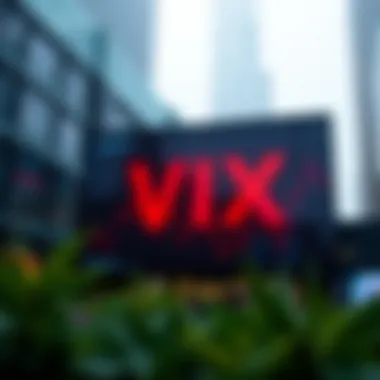Exploring the CBOE Equity VIX: Market Volatility Insights


Intro
Understanding market volatility is crucial for anyone involved in investing or managing portfolios. At the center of this analysis lies the CBOE Equity VIX, an index constructed to measure the market's expectations of future volatility based on options pricing of the S&P 500. Investors and analysts often refer to the VIX as the "fear gauge" because it reflects the level of uncertainty or risk in the market. Its fluctuations can signal potential shifts in market sentiment, making it an essential tool for both novice and seasoned investors alike.
Diving into the mechanics of the VIX will not only demystify its workings but also reveal its implications in investment strategies. This exploration will cover everything from definitions and key terms to expert strategies, ensuring that a wide spectrum of readers, from beginners to veterans, walks away with a firmer grasp on this pivotal financial instrument.
Definitions and Terminology
When engaging with the Equity VIX, a firm understanding of related concepts is paramount. Familiarizing oneself with pertinent terms can greatly enhance comprehension of market dynamics and VIX functionality.
Comprehensive Investment Terms
- Volatility: A measure of price fluctuations over time, indicating how much a financial instrument deviates from its average price. High volatility suggests significant price changes, while low volatility indicates stability.
- Options Pricing: The costs associated with purchasing options, which are contracts giving the buyer the right but not the obligation to buy or sell an underlying asset at a predetermined price.
- S&P 500: An index comprising 500 of the largest companies in the U.S., serving as a benchmark for U.S. equities and often correlated with general market performance.
Common Financial Jargon
- Bear Market: A prolonged period of declining prices, typically marked by a downturn of 20% or more in securities.
- Bull Market: An upward trend in stock prices, generally occurring when investor confidence and market performance are high.
- Implied Volatility: A metric used to forecast future volatility based on market prices of options, reflecting market sentiment.
Expert Advice
Understanding volatility is only half the equation. There are varied strategies one can adopt depending on their level of experience.
Strategies for Beginner Investors
- Start with small investments in VIX-related ETFs to build familiarity with how these instruments react to market changes.
- Consider using VIX as a hedge during market downturns. Purchasing options when VIX is low can provide protection against adverse market conditions.
Advanced Techniques for Seasoned Investors
- Utilize VIX futures to speculate on future volatility. Those with a keen sense of market trends might find profit opportunities in rapid shifts.
- Explore VIX options strategies like straddles and strangles to capitalize on high volatility moments, designed specifically for those who anticipate significant price movements.
"The VIX isn't just a number; it's the market's pulse. Monitoring its fluctuations can uncover critical insights into investor sentiment and potential market moves."
Prelude to CBOE Equity
The CBOE Equity VIX serves as a vital indicator of market volatility and investor sentiment, particularly for those participating in financial markets. This article seeks to clarify its critical role in investment strategies and decision-making processes. Understanding the VIX can ultimately aid investors in anticipating market movements, thus mitigating risks associated with volatility.
Understanding the Index
The VIX, often dubbed the "fear index," reflects the market's forecast of future volatility based on S&P 500 options pricing. When the VIX rises, it generally indicates that investors expect heightened volatility, often associated with increased uncertainty in the market. Conversely, a lower VIX value typically points to a calmer market environment. This relationship between the VIX and market conditions helps investors infer potential stock performance.
For example, during economic downturns or geopolitical tensions, the VIX tends to spike as traders brace for significant market fluctuations. This can lead to increased hedging activities using options, as investors seek to protect their portfolios against sharp declines. Understanding these dynamics provides traders and investors with insights that could be pivotal during times of uncertainty.
History of the Development
The VIX index was developed by the Chicago Board Options Exchange (CBOE) in 1993, marking a significant step in the world of financial derivatives. Initially, the VIX functioned differently, relying on a simpler model to measure volatility. Over the years, its methodology has evolved, incorporating a wider array of options data and a more refined formula for calculating volatility.
This evolution reflects an ongoing desire to enhance reliability and transparency. The new model was introduced in 2003, which considered a broader selection of options and emphasized near-term contracts. As the financial landscape has evolved, so too has the importance of the VIX. Nowadays, it not only indicates volatility but also influences financial instruments ranging from options to structured products.
"Understanding the history of the VIX is crucial for investors to grasp how volatility measures have adapted to changing market environments."
Through these developments, the VIX has established itself as a cornerstone of risk management, employed by traders and portfolio managers worldwide. With its enduring relevance, the VIX continues to play a crucial role in navigating the complexities of the financial markets.


Mechanics of the
The mechanics behind the CBOE Equity VIX stand as a fundamental aspect for anyone aiming to navigate the choppy waters of financial markets. Understanding these mechanics equips investors with a sharp toolset for analyzing market volatility, guiding not just trading strategies but also providing insight into broader economic conditions. The VIX not only tracks expectations of market fluctuations but also serves as a reflection of investor sentiments, acting as a barometer of fear and uncertainty in the stock market.
Calculating the
Calculating the VIX may seem daunting at first, but it boils down to a few critical steps. The VIX is derived primarily from the prices of S&P 500 index options, specifically those that are both at-the-money (ATM) and out-of-the-money (OTM).
Essentially, the formula blends a variety of option pricing data, particularly focusing on non-outliers, to arrive at a 30-day expected volatility. The key takeaway here is that the value of the VIX reflects the market's expectation of future volatility, and as such, fluctuates based on investor sentiment and market dynamics. This calculated figure is updated in real time, allowing traders to make informed choices that align with the currents of market confidence or trepidation.
Key Components of the Calculation
Understanding the nuances of the VIX calculation relies on grasping its key components. Some of the main elements include:
- Option Prices: The prices of S&P 500 index options feed directly into the VIX calculation, particularly focusing on both calls and puts. These serve to gauge investor expectations.
- Time to Expiration: The VIX primarily analyzes options that will expire within the next 30 days, which ensures that the index reflects current market conditions and sentiment, not historical data.
- Strike Prices: The specific strike prices available in the market play a crucial role. The VIX does not consider strikes that are too far out of the money, as they represent lesser probabilities of execution.
- Volatility Inputs: A mix of implied volatility from these options helps construct the expected market volatility, which is at the heart of the VIX value.
Each one of these components helps create a composite measure, which not only reflects current volatility expectations but also indicates whether the market is bracing itself for larger swings. This unique measurement capability of the VIX sets it apart from other volatility indices.
Interpreting Values
Interpreting the VIX values provides investors with insights into market expectations. Generally speaking, a VIX reading under 20 signals a relatively calm market environment—things are stable, and investors might feel secure. Conversely, when the VIX surges above 30, it often indicates heightened fear among market participants, suggesting that investors are expecting increased volatility, which can stem from possible economic shocks or geopolitical tensions.
Understanding VIX values can be likened to reading the weather forecast. Just as a high-pressure system might indicate calm skies, a low VIX suggests tranquility in the markets. Alternatively, a high VIX might hint at storms ahead, urging investors to proceed with caution.
Ultimately, the VIX serves as not just a number but as a narrative about market sentiment. Investment decisions can be adjusted based on these readings; for instance, a rising VIX might lead a discerning investor to adopt a more defensive posture in their portfolio. As such, staying attuned to the nuances of the VIX can significantly enhance one’s investment strategy and understanding of market trajectories.
Importance of the in Financial Markets
Understanding the significance of the VIX in today’s financial ecosystem helps investors and analysts gauge the state of market volatility. The VIX, fundamentally a measure of anticipated volatility in the S&P 500 index options, serves not only as a reflection of current market sentiment but also sheds light on future expectations. In a world where financial landscapes can change in the blink of an eye, the ability of the VIX to encapsulate this volatility provides clarity.
as a Market Sentiment Indicator
The VIX is often dubbed the "fear gauge," as it reflects investors' expectations of volatility over the next 30 days. When the VIX rises, it suggests that market participants anticipate increased volatility, which generally corresponds to heightened fear or uncertainty. Conversely, a declining VIX indicates a calmer market, where investors feel more secure.
This inverse relationship to market movements makes the VIX an invaluable tool for investors when assessing market conditions. Here are some elements to consider:
- Investor Psychology: The VIX captures the collective mood of market participants. A spike may indicate panic selling, while stability suggests a return to normalcy.
- Risk Assessment: Investors often utilize VIX readings to judge when to re-evaluate their exposure to risk. A high VIX might trigger a defensive strategy, while a low VIX may encourage risk-taking.
- Timing for Trades: Traders monitor the VIX closely to make timing decisions for entering or exiting positions.
In light of these factors, it’s evident the VIX isn’t just a number; it’s a narrative of market sentiment that influences investment strategies.
Correlation with Market Movements
The correlation between the VIX and market movements is compelling. As market indices fluctuate, so does the VIX, but the relationship is not strictly linear; it can be influenced by numerous factors.
- Historical Analysis: Historically, the VIX tends to rise sharply during market downturns, often moving inversely to the S&P 500. This behavior during market corrections underscores its role as a predictive tool.
- Market Context: It’s crucial to interpret the VIX in context. For example, during bull markets, a low VIX reflects investor confidence, while during bear markets, a high VIX serves as a warning.
- Unexpected Events: Economic reports, geopolitical tensions, or unforeseen global events can cause sudden spikes in the VIX, disrupting typical patterns. These spikes signal heightened uncertainty and prompt investors to reevaluate their strategies.
In summary, understanding how the VIX correlates with market movements provides traders and investors with actionable insights. This awareness allows market participants to navigate the often turbulent waters of financial markets more adeptly.
"The VIX is not merely a number; it is a reflection of investor sentiment, fears, and expectations that guide financial decision-making."
By keeping a keen eye on the VIX, investors can improve their market timing and risk management strategies, ultimately leading to more informed financial decisions.
Using the for Investment Decisions


Understanding the CBOE Equity VIX can serve as a pivotal element in strategic investment decisions. Investors, both seasoned and those just dipping their toes in the market waters, find value in harnessing its predictive power. The VIX acts as a mirror to market sentiment, reflecting investors’ expectations of future volatility. When used effectively, it can guide investment choices, allowing for more informed risk management.
VIX-Based Trading Strategies
Implementing VIX-based trading strategies can enhance returns and manage risk in fluctuating markets. Much like reading the tea leaves, assessing the VIX can help investors predict potential market movements. Here are several strategies that traders might consider:
- Long VIX: In periods of heightened uncertainty, bullish investors may buy VIX calls to capitalize on increasing volatility. An uptick in the VIX often accompanies market downturns, making this a typical hedge against losses in equities.
- Short VIX: Conversely, when the market appears stable, some traders opt to short the VIX to profit from decreasing volatility. Here, the goal is to capitalize on lower VIX values, which often occur in bullish market conditions.
- Spread Strategies: Utilizing options on the VIX can allow investors to execute spread trades. For example, a calendar spread, where one VIX call is sold and another is bought at a different expiry date, can provide a controlled risk environment.
Incorporating these strategies requires a keen analysis of VIX trends, along with an understanding of the broader market environment. Speculation on the VIX based on market sentiment can lead to opportunities, but it's worth remembering that timing is everything.
Incorporating in Portfolio Management
Using the VIX in portfolio management elevates the investment approach. For those looking to balance risk versus reward, the VIX provides an essential tool. Investors can use it to gauge when to reassess asset allocation, especially during volatile market phases.
Here are several considerations for incorporating the VIX into portfolio strategies:
- Hedging: Investors can offset potential losses in their portfolios by utilizing VIX derivatives. When volatility rises, the value of VIX options often increases, offering a natural hedge.
- Tactical Adjustments: The VIX can help determine when to adjust tactical allocations within the portfolio. For instance, if the VIX spikes significantly, it might signify a good time to move funds to safer assets, like bonds, during heightened market stress.
- Risk Assessment: Evaluating the VIX alongside other financial metrics allows investors to assess risk more holistically. A stark rise in VIX could signal underlying market instability, prompting a closer evaluation of current investments.
In essence, leveraging the VIX in investment decisions opens a world of strategic possibilities. It empowers investors to become proactive rather than reactive—separating the casual investor from those who truly understand making informed decisions based on market signals.
The CBOE VIX is not just an index; it's a tool for navigating the complexities of financial markets, offering vital insights into future volatility.
To deepen your knowledge further, consider exploring resources like CBOE for insights on VIX trading or MarketWatch for current market sentiment trends.
and Its Derivatives
The CBOE Equity VIX has carved out a notable niche for itself in the financial landscape, serving as a go-to measure for market volatility. As we navigate this dense forest of financial instruments, the derivatives linked to the VIX show a unique capacity to facilitate strategic maneuvering. Investors, whether seasoned or fresh-faced, should grasp the significance of these derivatives in order to enhance their trading strategies and manage risks effectively.
Futures and Options
When we talk about VIX futures and options, we enter a realm that can be a double-edged sword. On one hand, VIX futures allow investors to bet on the future direction of volatility. They essentially represent an agreement to buy or sell the VIX at a set price on a predetermined date. This can be an effective strategy for hedging against market downturns, as rising volatility typically correlates with dropping stock prices. The allure lies in the fact that futures contracts can be traded without ever needing to own the underlying asset, making them accessible to a wider range of investors.
"Using VIX futures strategically can provide a buffer against the unpredictability of markets, especially during turbulent times."
On the other hand, VIX options carry their own charm. They provide the right, but not the obligation, to buy or sell VIX futures. This flexibility makes options an attractive tool for investors. They can speculate on volatility spikes or mitigate risks without requiring large capital outlays. However, it’s essential to keep a weather eye on the expiration dates of these options, as they can erode in value if not utilized timely. The specifics of contract terms and market conditions are vital in shaping an optimal strategy.
Some key benefits of trading VIX futures and options include:
- Hedging: They serve as a safety net during market downturns.
- Speculation: Traders can profit from anticipated volatility spikes.
- Leverage: Smaller investments can control larger positions, amplifying potential returns.
However, investors must weigh these benefits against the inherent risks, such as market unpredictability and potential losses from miscalculating volatility movements.
Exchange-Traded Products Linked to the
Exchange-Traded Products (ETPs) linked to the VIX offer a more user-friendly way for investors to gain exposure to volatility without delving into the intricate world of futures and options. These instruments are designed to track the performance of the VIX or related indices, thereby making it easier to incorporate volatility into an investment strategy.
Some popular ETPs include VXX, UVXY, and SVXY, each with its objectives and risk profiles. For example, VXX provides exposure to the short-term VIX futures, while UVXY aims for leveraged returns on these futures. They are typically more accessible and liquid than individual futures contracts, allowing investors to trade them within a day’s span like stocks.
However, while ETPs present a more digestible avenue for participating in VIX-related trading, they are not without their pitfalls. ETPs often lag behind actual VIX performance due to management fees and tracking errors. Additionally, due to the nature of the underlying assets, these products can be volatile on their own.
In summary, understanding the role of VIX derivatives is crucial for making informed investment decisions. Grasping both the potentials and pitfalls allows for a more nuanced approach to volatility trading.
Analyzing Trends


Understanding how the CBOE Equity VIX behaves over time is crucial for investors looking to navigate financial markets effectively. Analyzing VIX trends enables market participants to capture shifts in investor sentiment and volatility, which often foretell broader market movements. This section breaks down the importance of scrutinizing VIX trends, along with historical performance and the effects of economic events.
Historical Trends of the
Examining historical trends of the VIX provides a comprehensive backdrop against which current market conditions can be assessed. Investors often look to the VIX’s past to gauge potential future movements, making its historical data invaluable.
- Fluctuations over Time: The VIX has experienced dramatic swings, particularly during market crises. For example, during the 2008 financial crisis, the VIX spiked to unprecedented levels, reflecting extreme investor fears. Similarly, the COVID-19 pandemic triggered a surge in volatility, sending the VIX soaring again.
- Patterns and Cycles: Understanding these fluctuations can aid in predicting future VIX movements. For instance, the VIX tends to rise during periods of high market uncertainty and drop when confidence returns. Recognizing these cycles equips investors with better foresight, prompting them to make informed decisions about buying or hedging.
- Benchmarking: The use of historical VIX data as a benchmark is another important aspect. By comparing current VIX levels against historical averages, investors can discern whether the market is currently experiencing elevated volatility or relative calm. This context is essential when evaluating potential trading strategies.
Impact of Economic Events on the
Economic events significantly influence the VIX. Understanding this relationship can illuminate why certain market conditions lead to higher volatility.
- Economic Reports: Release of major economic indicators, such as employment data or inflation rates, often leads to fluctuating market expectations. For example, an unexpectedly high unemployment rate may spike the VIX as fears about economic health grow.
- Central Bank Decisions: Decisions made by central banks, such as interest rate changes or quantitative easing measures, also have significant impacts on market volatility. A surprise rate hike, for instance, can send the VIX up as investors reconsider their market positioning.
- Geopolitical Events: Beyond economic data, geopolitical tensions—like trade disputes or military conflicts—can cause abrupt changes in the VIX. Investors typically react to these uncertainties with increased caution, pushing the VIX upward.
"Understanding the dance between the VIX and economic events is critical for those wishing to stay a step ahead in volatile markets."
Future Prospects of the
The ongoing evolution of the CBOE Equity VIX is an important topic for investors and market analysts alike. Understanding the future prospects of the VIX not only informs individual investment strategies but also greatly influences market psychology and risk management behaviors. As the landscape of financial markets continually shifts due to technological advancements and economic fluctuations, the VIX stands at a pivotal intersection of these changes. This section delves into potential changes within the VIX landscape and offers guidance tailored for future investors.
Potential Changes in the Landscape
As we look toward the future, several developments can alter how the VIX operates. Here are some noteworthy changes that could shape its trajectory:
- Technological Innovations: The rise of algorithms and machine learning can enhance volatility forecasting methods. These technologies may allow for real-time updates to VIX calculations, making it more responsive to sudden market shifts.
- Regulatory Adjustments: Changes in financial regulations could introduce new VIX-based products. Such changes may either expand or narrow the scope of how the VIX is interpreted in the broader market context.
- Global Economic Trends: Various geopolitical events or economic policies abroad can influence global market volatility, affecting the VIX indirectly. Investors should be on the lookout for shifts in trade relations or international economic sanctions that could impact VIX trends.
- Market Sentiment Measures: There’s growing interest in alternative volatility measures that can complement the VIX. New indexes focused on other asset classes or derivatives might emerge, potentially leading to a proliferation of volatility metrics.
The VIX is thus far more than a mere number; it reflects broader trends and investor psyche. Adapting to these changes will be vital for investors aiming to stay ahead.
Advice for Future Investors
Navigating the future of the VIX requires a strategic approach. Here are some practical tips for investors looking to leverage this instrument:
- Stay Informed: Given that market conditions can shift quickly, keeping up with financial news and economic indicators is crucial. Websites like Investopedia and Reuters are valuable resources for real-time financial news.
- Diversify Strategies: Investors should consider not only VIX-based instruments but also traditional equities and bonds. This balanced approach reduces risk while providing various avenues for profit.
- Educate on VIX Mechanics: Understanding how the VIX calculation works and its behavioral patterns allows for better predictions regarding market volatility. Resources like Wikipedia provide excellent background material on these topics.
- Prepare for Market Uncertainty: The VIX is inherently linked to fear and market fluctuations. Investors should be prepared for volatility, ensuring their portfolios can withstand economic downturns.
- Utilize VIX Derivatives Wisely: Options and futures tied to the VIX can be potent tools, but they come with significant risk. Familiarizing oneself with these instruments, possibly through simulations or educational resources, can pave the way for more effective investment decisions.
Informed decision-making is king. Understanding the VIX landscape is crucial to navigating future uncertainties.
In summary, keeping an eye on the trends surrounding the VIX and adopting adaptable strategies may offer a leg up in financial markets. Investors who do this will be better equipped for the surprises and challenges that lie ahead.
The End
In wrapping up our exploration of the CBOE Equity VIX, it's clear that this index is more than just a number tossed around in financial discussions; it acts as a crucial compass for investors navigating the turbulent seas of market volatility. Understanding the VIX provides insights not only into past and present market conditions but also equips investors with essential knowledge for future strategies.
Recap of Key Insights
Throughout this article, we have illuminated several key aspects of the VIX:
- Market Indicator: The VIX serves as a barometer for investor sentiment, highlighting fear and uncertainty within the markets. This role cannot be overstated, as it directly influences investment strategies and market reactions.
- Calculating Volatility: We explored the nuts and bolts of how the VIX is calculated. Knowing its components helps investors grasp why the number moves as it does, allowing them to make informed decisions.
- Investment Strategies: From trading options to integrating VIX measures into broader portfolio management, the VIX opens various pathways for effectively managing risk. Understanding how to utilize the VIX can arm investors with a more nuanced approach to their portfolios.
The implications of the VIX traverse a wide spectrum, impacting how investors gauge their risk tolerance and make decisions.
Final Thoughts on the 's Role
As we look ahead, the role of the VIX is likely to evolve amidst changing market dynamics. Economic indicators, global events, and new financial products continually reshape the landscape.
"Investors who understand the VIX not only take better control of their positions but can also adapt swiftly to changing market conditions."
In essence, the VIX stands as a vigilant sentry, signaling when to brace for market storms or seize opportunities amidst chaos. For both novice and seasoned investors, mastering the intricacies of the VIX can spell the difference between fortunes gained and losses mitigated.















